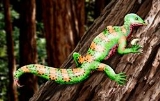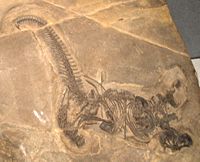
Drepanosaurus
Encyclopedia
Drepanosaurus is a genus
of arboreal (tree-dwelling) reptile
that lived during the Triassic
Period. Only one specimen of Drepanosaurus has thus far been found. Sadly this specimen was incomplete and lacked a head and neck. Drepanosaurus was probably an insectivore, and lived in a coastal environment in what is now modern Italy.

The forelimb of Drepanosaurus is QUITE highly modified compared to other vertebrates and very robust. Its ulna
was altered from being a forearm bone into an odd crescent shaped site for muscle attachment. The role played by the ulna in most tetrapod
s is replaced by an elongated carpal bone. Additional musculature would be attached to the high withers
that characterized Drepanosaurus and its close relatives.
A clue to the purpose of these large muscles can be found on its hand. The animal's "index finger" bore a large claw reminiscent of those born by dinosaurs such as Noasaurus
and Baryonyx
. However it is more likely that Drepanosaurus used its claw like the modern pygmy anteater, tearing through bark and insect nests to find invertebrate prey. Some researchers have forwarded the more far-fetched proposal that the claw was used to excavate burrows, but this is unlikely.
Genus
In biology, a genus is a low-level taxonomic rank used in the biological classification of living and fossil organisms, which is an example of definition by genus and differentia...
of arboreal (tree-dwelling) reptile
Reptile
Reptiles are members of a class of air-breathing, ectothermic vertebrates which are characterized by laying shelled eggs , and having skin covered in scales and/or scutes. They are tetrapods, either having four limbs or being descended from four-limbed ancestors...
that lived during the Triassic
Triassic
The Triassic is a geologic period and system that extends from about 250 to 200 Mya . As the first period of the Mesozoic Era, the Triassic follows the Permian and is followed by the Jurassic. Both the start and end of the Triassic are marked by major extinction events...
Period. Only one specimen of Drepanosaurus has thus far been found. Sadly this specimen was incomplete and lacked a head and neck. Drepanosaurus was probably an insectivore, and lived in a coastal environment in what is now modern Italy.

Anatomy
A full sized adult Drepanosaurus had a length of about half a meter. Its name means "scythe lizard", which is thought to refer either to the enlarged claw on its forelimb, or the claw-like structure at the tip of its prehensile tail. The structure at the end of the tail is made of fused vertebrae.The forelimb of Drepanosaurus is QUITE highly modified compared to other vertebrates and very robust. Its ulna
Ulna
The ulna is one of the two long bones in the forearm, the other being the radius. It is prismatic in form and runs parallel to the radius, which is shorter and smaller. In anatomical position The ulna is one of the two long bones in the forearm, the other being the radius. It is prismatic in form...
was altered from being a forearm bone into an odd crescent shaped site for muscle attachment. The role played by the ulna in most tetrapod
Tetrapod
Tetrapods are vertebrate animals having four limbs. Amphibians, reptiles, birds and mammals are all tetrapods; even snakes and other limbless reptiles and amphibians are tetrapods by descent. The earliest tetrapods evolved from the lobe-finned fishes in the Devonian...
s is replaced by an elongated carpal bone. Additional musculature would be attached to the high withers
Withers
The withers is the ridge between the shoulder blades of a four-legged animal. In many species it is the tallest point of the body, and in horses and dogs it is the standard place to measure the animal's height .-Horses:The withers in horses are formed by the dorsal spinal processes of roughly the...
that characterized Drepanosaurus and its close relatives.
A clue to the purpose of these large muscles can be found on its hand. The animal's "index finger" bore a large claw reminiscent of those born by dinosaurs such as Noasaurus
Noasaurus
Noasaurus is the name given to a carnivorous dinosaur genus of the late Campanian-Maastrichtian...
and Baryonyx
Baryonyx
Baryonyx is a genus of carnivorous saurischian dinosaur first discovered in clay pits just south of Dorking, England, and later reported from fossils found in northern Spain and Portugal. It is known to contain only one species, Baryonyx walkeri...
. However it is more likely that Drepanosaurus used its claw like the modern pygmy anteater, tearing through bark and insect nests to find invertebrate prey. Some researchers have forwarded the more far-fetched proposal that the claw was used to excavate burrows, but this is unlikely.

